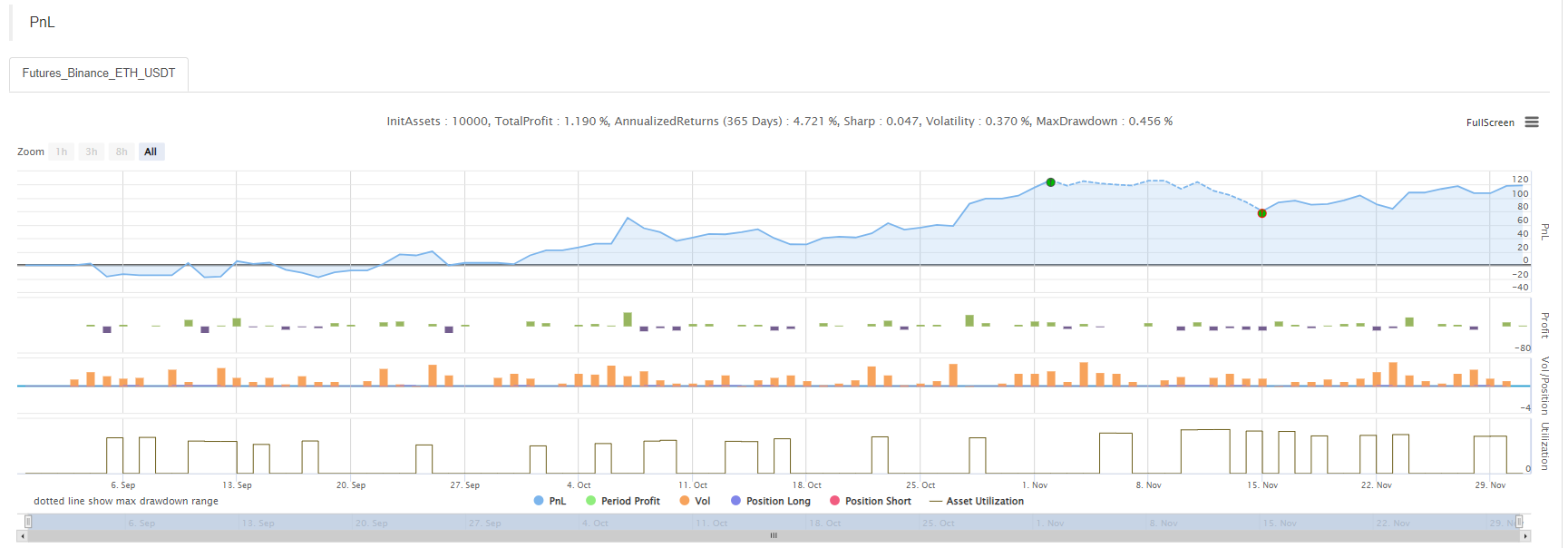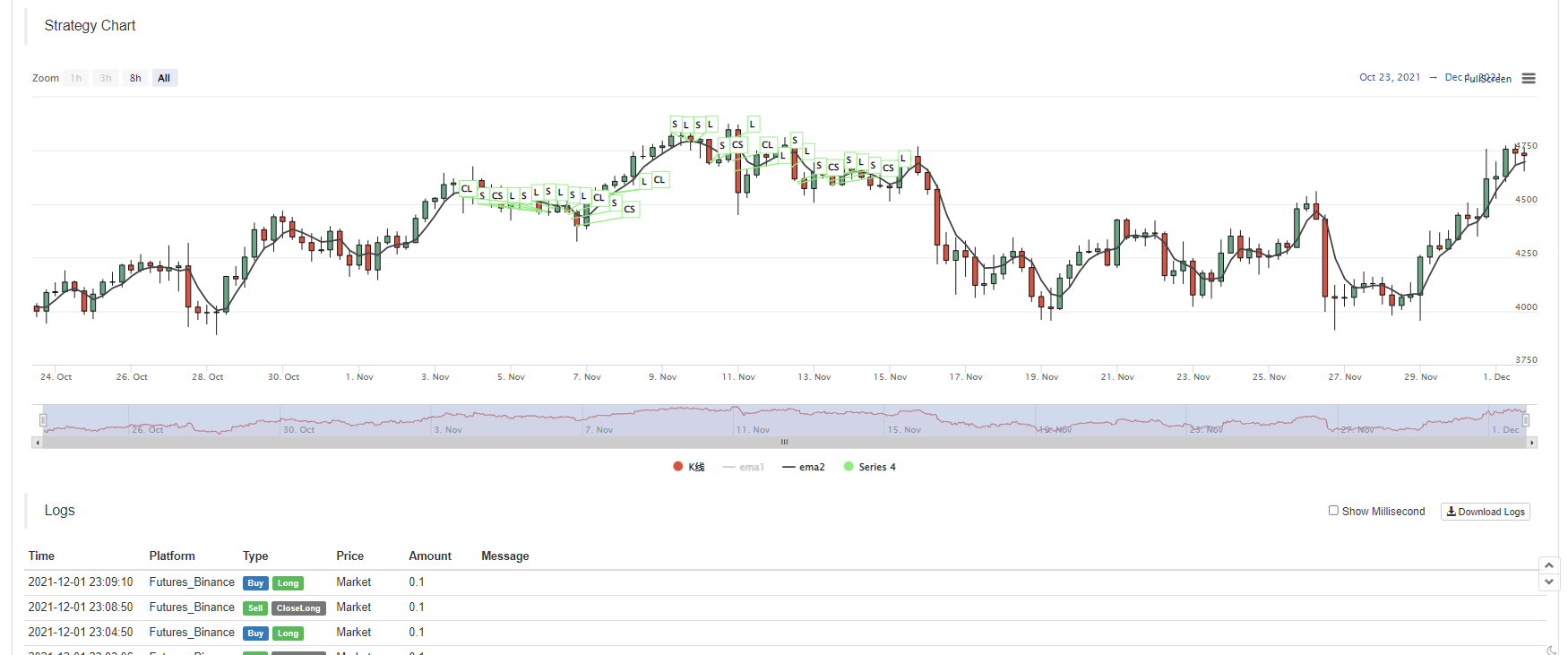Stratégie de point de rupture à moyenne mobile double des contrats à terme sur crypto-monnaie (enseignement)
Auteur:Je suis désolée., Créé à partir de: 2022-04-08 11:46:22, mis à jour à partir de: 2022-04-08 11:58:28Stratégie de point de rupture à moyenne mobile double des contrats à terme sur crypto-monnaie (enseignement)
Cet article explique la conception d'une stratégie de tendance simple, uniquement à partir du niveau de conception de la stratégie, pour aider les débutants à apprendre à concevoir une stratégie simple et à comprendre le processus d'exécution du programme de stratégie.
Conception de la stratégie
Lorsque l'on utilise les deux indicateurs EMA et que les deux moyennes mobiles ont un point de rupture, les points de rupture sont utilisés comme signal pour ouvrir des positions longues et courtes (ou inverser), pour concevoir une cible fixe pour le profit de l'écart de fermeture des positions.
Code de stratégie
/*backtest
start: 2021-09-01 00:00:00
end: 2021-12-02 00:00:00
period: 1h
basePeriod: 5m
exchanges: [{"eid":"Futures_Binance","currency":"ETH_USDT"}]
*/
// above /**/ inside these are the default backtest settings; the backtest page can be reset by the related controls on the backtest page
var LONG = 1 // mark of holding long positions; enum constant
var SHORT = -1 // mark of holding short positions; enum constant
var IDLE = 0 // mark of not holding no position; enum constant
// obtain the positions with a specified direction; positions indicates position data; direction indicates the direction of the positions to be obtained
function getPosition(positions, direction) {
var ret = {Price : 0, Amount : 0, Type : ""} // define a structure when holding no position
// traverse positions, among which find the positions conforming to the direction
if (pos.Type == direction) {
ret = pos
}
})
// return the positions found
return ret
}
// cancel all pending orders of the current trading pair and contract
function cancellAll() {
// infinite loop, detect without stop, until break is triggered
while (true) {
// obtain the pending orders data of the current trading pair and contract, namely orders
var orders = _C(exchange.GetOrders)
if (orders.length == 0) {
// when orders is a null array, namely orders.length == 0, execute "break" statement to break the while loop
break
} else {
// traverse all the current pending orders, and cancel them one by one
for (var i = 0 ; i < orders.length ; i++) {
// the function to cancel a specified order, canceling the order with an ID of:orders[i].Id
exchange.CancelOrder(orders[i].Id, orders[i])
Sleep(500)
}
}
Sleep(500)
}
}
// function of closing position, which executes close position, according to the passed tradeFunc and direction
function cover(tradeFunc, direction) {
var mapDirection = {"closebuy": PD_LONG, "closesell": PD_SHORT}
var positions = _C(exchange.GetPosition) // obtain the position data of the current trading pair and contract
var pos = getPosition(positions, mapDirection[direction]) // find the position information of the specified close position direction
// when position volume is over 0 (only when there is a position, you can operate close position)
if (pos.Amount > 0) {
// cancel all possibly existing pending orders
cancellAll()
// set trading direction
exchange.SetDirection(direction)
// execute close position tradefunc
if (tradeFunc(-1, pos.Amount)) {
// if ordering successfully, return true
return true
} else {
// if the ordering fails, return false
return false
}
}
// no position returns true
return true
}
// strategy main function
function main() {
// used to switch to OKEX V5 simulated bot
if (okexSimulate) {
exchange.IO("simulate", true) // switch to OKEX V5 simulated bot to test
Log("switch to OKEX V5 simulated bot")
}
// set contract code; set ct to swap, namely set the current operated contract to a perpetual contract
exchange.SetContractType(ct)
// the initial status is no position
var state = IDLE
// the initial position price is 0
var holdPrice = 0
// innitialize the timestamp for comparison, to compare whether the current K-line BAR changes
var preTime = 0
// strategy main loop
while (true) {
// obtain the K-line data of the current trading pair and contract
var r = _C(exchange.GetRecords)
// obtain the K-line length, namely 1
var l = r.length
// judge the K-line length of 1, which has to be longer than the indicator period (if the length is less than the indicator period, the indicator function cannot calculate the effective indicatorr data); if not, the loop will be restarted
if (l < Math.max(ema1Period, ema2Period)) {
// wait 1000 miliseconds, namely 1 second, to avoid rotating too fast
Sleep(1000)
// ignore the code after "if" at the moment, and restart the while loop
continue
}
// calculate EMA indicator data
var ema1 = TA.EMA(r, ema1Period)
var ema2 = TA.EMA(r, ema2Period)
// plot
$.PlotRecords(r, 'K-line') // draw K-line chart
// when the timestamp of the last BAR changes, namely when the new K-line BAR is generated
if(preTime !== r[l - 1].Time){
// before the new K-line BAR is generated, it is the last update of the last BAR
$.PlotLine('ema1', ema1[l - 2], r[l - 2].Time)
$.PlotLine('ema2', ema2[l - 2], r[l - 2].Time)
// draw the EMA lines of the new BAR, namely the EMA indicator data on the current last BAR
$.PlotLine('ema1', ema1[l - 1], r[l - 1].Time)
$.PlotLine('ema2', ema2[l - 1], r[l - 1].Time)
// update the timestamp for comparison
preTime = r[l - 1].Time
} else {
// at the moment when there is no new BAR generated, just update the EMA indicator data of the last BAR in the chart
$.PlotLine('ema1', ema1[l - 1], r[l - 1].Time)
$.PlotLine('ema2', ema2[l - 1], r[l - 1].Time)
}
// condition of open long position, breakpoint
var up = (ema1[l - 2] > ema1[l - 3] && ema1[l - 4] > ema1[l - 3]) && (ema2[l - 2] > ema2[l - 3] && ema2[l - 4] > ema2[l - 3])
// condition of open short position, breakpoint
var down = (ema1[l - 2] < ema1[l - 3] && ema1[l - 4] < ema1[l - 3]) && (ema2[l - 2] < ema2[l - 3] && ema2[l - 4] < ema2[l - 3])
// when the condition of open long position is triggered and currently short positions are held, or when the condition of open long position is triggered but there is no position
if (up && (state == SHORT || state == IDLE)) {
// if holding short, close first
if (state == SHORT && cover(exchange.Buy, "closesell")) {
// after close positions, mark the status of no position
state = IDLE
// reset the position price to 0
holdPrice = 0
// mark on the chart
$.PlotFlag(r[l - 1].Time, 'coverShort', 'CS')
}
// after close positions, reverse to open long
exchange.SetDirection("buy")
if (exchange.Buy(-1, amount)) {
// mark the current status
state = LONG
// record the current price
holdPrice = r[l - 1].Close
$.PlotFlag(r[l - 1].Time, 'openLong', 'L')
}
} else if (down && (state == LONG || state == IDLE)) {
// similar to the judge of up condition
if (state == LONG && cover(exchange.Sell, "closebuy")) {
state = IDLE
holdPrice = 0
$.PlotFlag(r[l - 1].Time, 'coverLong', 'CL')
}
exchange.SetDirection("sell")
if (exchange.Sell(-1, amount)) {
state = SHORT
holdPrice = r[l - 1].Close
$.PlotFlag(r[l - 1].Time, 'openShort', 'S')
}
}
// stop profit
if (state == LONG && r[l - 1].Close - holdPrice > profitTarget && cover(exchange.Sell, "closebuy")) {
state = IDLE
holdPrice = 0
$.PlotFlag(r[l - 1].Time, 'coverLong', 'CL')
} else if (state == SHORT && holdPrice - r[l - 1].Close > profitTarget && cover(exchange.Buy, "closesell")) {
state = IDLE
holdPrice = 0
$.PlotFlag(r[l - 1].Time, 'coverShort', 'CS')
}
// display the time on the status bar
LogStatus(_D())
Sleep(500)
}
}


Le code source de la stratégie:https://www.fmz.com/strategy/333269
La stratégie n'est qu'un enseignement de conception de programme, alors s'il vous plaît ne l'utilisez pas dans un bot.
Plus de
- Réaliser un robot de supervision d'ordre simple de Cryptocurrency Spot
- Une plateforme de paiement basée sur FMZ
- Contrats de crypto-monnaie Robot simple de supervision des ordres
- Vous voulez obtenir le temps correspondant lorsque vous utilisez getdepth
- Ignoré, résolu
- Le problème de la valeur
- Exemple de conception de stratégie dYdX
- Exploration initiale de l'application de Python Crawler sur FMZ
Crawling Contenu de l'annonce de Binance - Définition de la stratégie de couverture Recherche et exemple d'ordres en attente au comptant et à terme
- Situation récente et fonctionnement recommandé de la stratégie de taux de financement
- Stratégie des moyennes mobiles doubles multi-symbole de crypto-monnaie (enseignement)
- Réalisation de l'indicateur Fisher en JavaScript et de la planification sur FMZ
- Le gérant
- 2021 Cryptocurrency TAQ Review & Stratégie manquée la plus simple d'augmentation de 10 fois
- Stratégie ART multi-symbole sur les contrats à terme de crypto-monnaie (enseignement)
- Mise à niveau! Stratégie de Martingale sur les contrats à terme de crypto-monnaie
- La fonction Getrecords n'arrive pas à récupérer le schéma de K en secondes
- Conception d'un système de gestion synchrone basé sur les ordres FMZ (2)
- Les données de volume retournées par Getticker sont incorrectes.
- Conception d'un système de gestion synchrone basé sur les ordres FMZ (1)